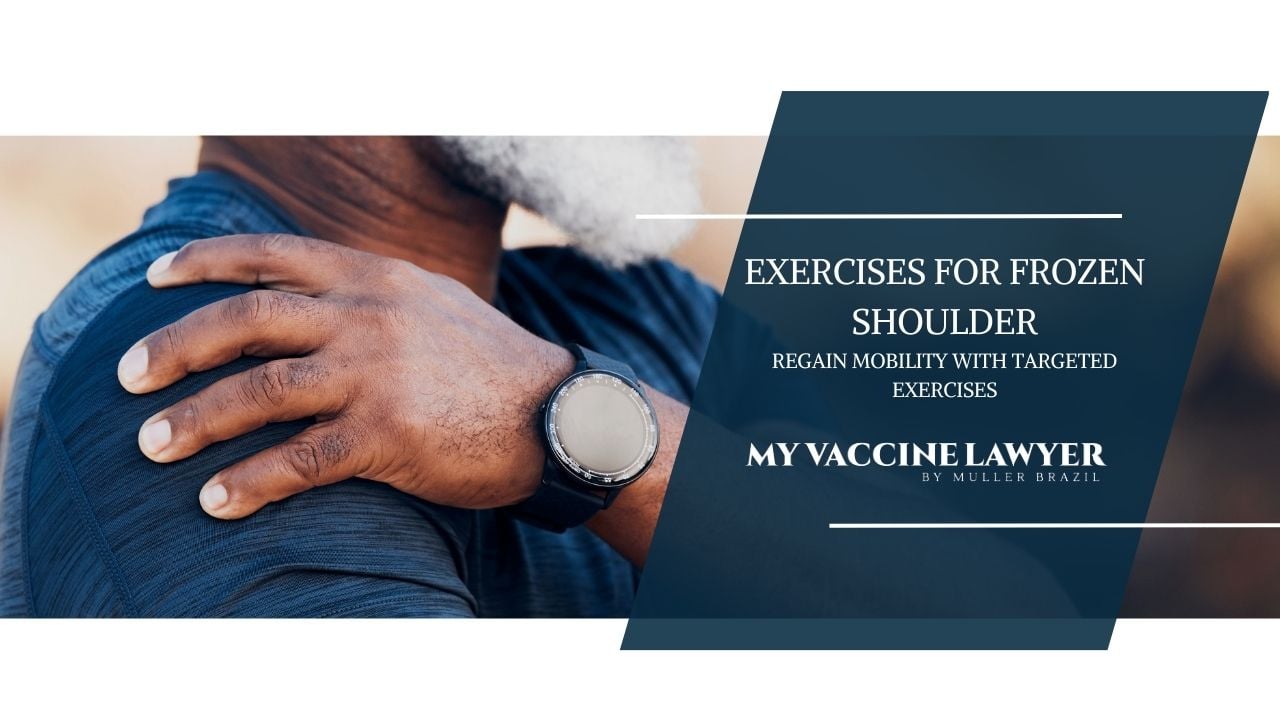SIRVA & GBS: Navigating Vaccine Injury Claims
For anyone who has experienced SIRVA (Shoulder Injury Resulting from Vaccine Administration) or Guillain-Barré Syndrome (GBS) after a vaccination,...
About Us
Vaccine Injury Lawyer
Types of Injuries
All Covered Vaccines
7 min read
Vaccine Injury Law Resources / SIRVA / Frozen Shoulder Exercises for SIRVA Relief
 Max Muller
:
Feb 12, 2024 5:34:34 PM
Max Muller
:
Feb 12, 2024 5:34:34 PM
Frozen shoulder, or adhesive capsulitis, affects 2% to 5% of people and causes pain with limited shoulder movement. It goes through three stages: freezing, where the pain starts; frozen, where the shoulder stiffens; and thawing, where mobility slowly gets better.
Sometimes, frozen shoulder happens after a vaccine is given wrongly, causing a condition called Shoulder Injury Related to Vaccine Administration (SIRVA). This occurs when a vaccine is injected into the shoulder joint or bursa instead of the deltoid muscle, leading to inflammation and symptoms like those of frozen shoulder.
Effective exercises for this condition include pendulum stretches, finger walks, and inward rotations to help improve flexibility and reduce pain. Treatment usually involves physical therapy along with heat or cold therapy to manage pain and swelling. Regular exercise and check-ins with healthcare professionals are important to adjust the treatment as needed and help recovery.
Frozen shoulder, medically known as adhesive capsulitis, is characterized by shoulder stiffness, pain, and a substantial loss of passive range of motion. Frozen shoulder occurs commonly in individuals who have immobilized their arm during recovery from a shoulder injury, arm fracture, stroke, or improperly administered vaccination.
This condition, frozen shoulder adhesive capsulitis, can be quite debilitating and may require medical intervention to regain normal function. In some cases, the development of scar tissue can contribute to the severity of the condition.
Inflammation of the shoulder joint capsule can also trigger this condition, even without a specific incident leading to it. Therefore, being aware of the risk factors and symptoms is vital for effective management of this condition.
.jpg?width=2240&height=1260&name=MVL%20template%20(7).jpg)
The key signs of a frozen shoulder are aching pain, stiffness, and a limited range of motion in the shoulder joint. Monitoring these symptoms is important as they may worsen post injury or surgery, particularly in instances of rotator cuff tear.
Underlying medical conditions can also increase the risk of developing a frozen shoulder. Factors such as:
are all considered risk factors.
Frozen shoulder develops and recedes in three stages:
As the condition progresses to the frozen and thawing stages, pain may decrease but the stiffness remains, with a gradual improvement in range of motion over time. A warm shower before performing exercises helps loosen the shoulder joint and reduces pain.
Management and improvement of frozen shoulder symptoms heavily rely on physical therapy exercises. The pendulum stretch, finger walk, and inward rotation are fundamental exercises that can notably increase mobility and reduce pain.
The pendulum stretch relaxes the shoulder and neck muscles, increasing flexibility and range of motion. The finger walk exercise improves mobility and flexibility in the shoulder joint, while inward rotation helps in building shoulder strength and relieving pain.
To perform the pendulum stretch, follow these steps:
The pendulum stretch should be performed multiple times per day to induce relaxation in the shoulder and neck muscles, ease the passive range of motion of the shoulder joint, and improve flexibility. However, avoid placing excessive tension on the shoulder, especially after surgical repair.
The finger walk exercise is performed by:
This exercise, using a rubber exercise band, targets specific muscles and is one of the effective strengthening exercises that improves the range of motion, promoting increased mobility over time. Incorporating stretching exercises alongside this activity can further improve flexibility and overall muscle health.
To achieve optimal results, perform the finger walk exercise 10 to 20 times a day. Nonetheless, it’s strongly advised to consult a healthcare professional or physical therapist prior to starting any exercise regimen for frozen shoulder.
Using a towel, the inward rotation exercise for the shoulder can be performed by securing the towel behind your back with the affected arm. With the opposite arm raised above your head, gently pull the towel upwards until a stretching sensation is felt in the affected shoulder.
Hold this position for 15 to 30 seconds, release, and return the towel to its initial position. This exercise is beneficial as it helps build shoulder strength and gradually relieves pain. It is recommended to be performed three times a day.
In moderate to severe cases of frozen shoulder, advanced exercises such as cross-body stretch and doorway external rotation can be used to further improve flexibility and strength.
These exercises are typically more intense and require greater shoulder mobility, making them suitable for individuals who have already made some progress in their frozen shoulder recovery. Nevertheless, always make sure to consult a healthcare professional before starting any new exercise regimen to prevent aggravating the condition.
The cross-body stretch involves:
This exercise improves mobility and flexibility in the shoulder joint. Yet, if you’re experiencing severe pain, don't perform the cross-body stretch. Also, sudden or jerky movements with the shoulder should be avoided to prevent worsening any existing injury.
Take Control of Your Injury Today
The doorway external rotation involves standing in a doorway and firmly holding the elbow of the affected arm against your body. Then, bend the arm at a 90-degree angle and grasp the doorframe. This exercise targets the infraspinatus muscle and the rotator cuff muscles, providing increased mobility and flexibility.
Perform this exercise for 2-3 sets of 10-12 repetitions, at least once or twice daily. Like all exercises, maintaining the correct posture and form is important to prevent additional harm to the shoulder.
Although exercises are a key part of frozen shoulder recovery, physical therapy, and home remedies are equally significant. Physical therapy helps:
Home remedies like heat and cold therapy can also aid in the healing process and provide pain relief. Heat therapy increases blood circulation, while cold therapy diminishes inflammation and eases discomfort.
Heat and cold therapy, such as applying ice packs or heating pads, significantly reduces shoulder pain and inflammation. Ice packs should be applied to the affected shoulder for 10 to 15 minutes several times a day, within 24 to 72 hours of the onset of the injury or at the first sign of pain and swelling.
Heat therapy can be administered pre-exercise by taking a warm bath or shower for 10 to 15 minutes, or by applying a moist heating pad or hot pack.
Working with a physical therapist provides personalized guidance on exercises and techniques to improve shoulder mobility and function. A physical therapist helps track your progress and makes sure you're following safe healing protocol.
Regular check-ups with a physical therapist, at least once or twice a week, are also recommended for optimal recovery. However, it’s important to check that the physical therapist is appropriately qualified and experienced in treating frozen shoulder.
Preventing frozen shoulder involves:
Regular shoulder exercises help relieve discomfort and improve the range of motion, thus reducing the probability of developing this condition or aiding in its rehabilitation.
Incorporating regular shoulder exercises into your fitness routine help maintain flexibility and strength, reducing the risk of frozen shoulder. The pendulum stretch, towel stretch, and the football supporter shoulder exercise are effective for promoting shoulder flexibility and strength.
Perform these exercises at least once or twice daily for optimal results. Nonetheless, it’s imperative to be cautious and do these with the correct form to avoid inflicting additional damage to the shoulder.
Monitoring progress through regular check-ins with a healthcare professional or physical therapist helps identify any issues and adjust treatment plans as needed. Indicators of progress in a frozen shoulder condition include a reduction in pain and increased shoulder mobility.
Treatment plans may be adjusted to include:
Regular check-ups, every few weeks, are recommended as complete recovery may take as long as 9 months to a year.
An improperly administered vaccine can lead to inflammation and damage to the shoulder structures, resulting in pain, reduced range of motion, and other symptoms synonymous with a frozen shoulder. If left untreated, this condition can significantly impact your daily life and activities.
Contacting a vaccine injury attorney like My Vaccine Lawyer helps you deal with the legal process and seek compensation for any harm caused. Don't let a vaccine administration error leave you in pain. Reach out to My Vaccine Lawyer for assistance.
Frozen shoulder can be a significant obstacle to your daily activities, but with the right exercises, physical therapy, and home remedies, you can regain your mobility and live pain-free. Regular shoulder exercises and monitoring progress are also crucial in preventing and maintaining a healthy shoulder joint.
Everyone’s journey to recovery is unique, so consult with a healthcare professional or physical therapist to create a personalized treatment plan.
The fastest way to heal a frozen shoulder is through physical therapy, anti-inflammatory medication, and, in severe cases, steroid injections. Surgery is only considered if other treatments have failed to improve the range of motion and decrease pain.
To avoid worsening the symptoms of a frozen shoulder, do not remain immobile, abruptly move your arm or shoulder, or sleep on your affected shoulder. These actions can prolong symptoms and cause intense pain.
The root cause of frozen shoulder, also known as adhesive capsulitis, is usually inflammation in the shoulder joint's capsule, which restricts the movement of the shoulder bones.
Yes, it is okay to massage a frozen shoulder as it can help relieve tension and tightness and improve mobility. Additionally, massage may improve blood flow to the affected area and reduce inflammation.
Frozen shoulder, also known as adhesive capsulitis, is characterized by stiffness, pain, and a significant loss of passive range of motion in the shoulder.
Mr. Muller currently devotes the majority of his law practice to aggressively fighting for the victims of unsafe drug and medical device injuries, as well as vaccine injuries and vaccine reactions involving the flu shot, TDaP/DTaP vaccine, and more. He has handled hundreds of SIRVA injury cases (shoulder injury related to vaccine administration), especially those involving bursitis, tendonitis, frozen shoulder, and rotator cuff tears. Mr. Muller also handles cases where vaccines caused serious nerve injuries such as Guillain-Barre Syndrome. Mr. Muller has recovered millions of dollars in compensation for his clients in the Vaccine Injury Compensation Program.

For anyone who has experienced SIRVA (Shoulder Injury Resulting from Vaccine Administration) or Guillain-Barré Syndrome (GBS) after a vaccination,...

If you've experienced shoulder pain or limited mobility after a flu shot, you might have a SIRVA injury. This includes amounts for pain, suffering,...

Attorney Max Muller was retained by a woman who suffered a shoulder injury following a flu shot and pneumonia vaccine. Immediately following the...
